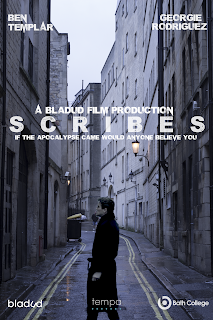So, all the blood sweat and tears have finally paid off. The sleepless nights and hectic days have all lead to a good end product. As a crew we worked together really well with each department puling it's weight in he uphill battle which is film making. But now is a time to reflect back on my own role as Director. In this post I hope to answer the important questions like what were the strengths & challenges and how did I overcome. Plus how I can progress in the industry in my chosen job role.
First things first likes start out with are best foot forward, Strengths. I felt that I was a very effective director when it came to putting my ideas and concepts across. As Quentin Tarantino says "being a good director isn't about being able to be good at everything to bring your vision to life, it's about explaining your vision to people that know what they are doing". I took that advice very much to heart during the production. Instead of having to think about multiply things at once (like I normally have to do when working) I instead honed on just on my role, focusing on working with the actors to get the best performances.
 This wasn't easy at times as in the past I have struggled with putting the ideas in my brain into actual words that make sense but, with some practise (and some patients from my amazing crew) we managed it. My crew mates seem to agree as well which is great after the stressfulness of working so closely on a project like Scribes.
This wasn't easy at times as in the past I have struggled with putting the ideas in my brain into actual words that make sense but, with some practise (and some patients from my amazing crew) we managed it. My crew mates seem to agree as well which is great after the stressfulness of working so closely on a project like Scribes. Another strength that I felt really help things along was coordination. Right from the beginning, I knew that if I wasn't organised that I would be totally overwhelmed by the task. Me and my DOP started work as early as we could on getting some test footage and storyboardings out the feel and style we wanted. Same goes with myself and the Producer during the casting process. I wanted to get the ball rolling on things as soon as possible so no to have things jump up at us when deadlines started getting tight.
My final Strength was working with the actors. As previously mentioned, I was able to really spend some time with them on set, helping them to understand their role and what I needed from them. This lead to two very good and believable performances. You can really feel that brother and sister relationship on screen, as well as Dans distress when his world starts to come crashing down around him.
However, you can't have strengths without some weaknesses. For me, my biggest weakness was my own lateness. Time keeping has always been an issue for me and this project was no different. If their is one thing I could do different from a role stand point it would be to have got everywhere an hour earlier than I did.
Unsurprisingly, with a project of this size their were a lot of challenges. One of the biggest issues we had came the night before are many studio shoot. We had purpose built a flat in a studio space but only had it for one day. However, in try film making style, one on the key cables for connection up the camera to an external monitor broke. This meant we wouldn't be able to use the camera crane the next day meaning we wouldn't have been able get a lot of the shots we needed. Nightmare! We walked around bath for hours searching high and low for a new cable but alas, nothing. That night I reserved one at a local electronics store. Then, that morning, I waited outside for them to open to be the first in to get the cable.
Overall, I have learnt a huge amount as a film maker and even more as a director. I will take away from this project the true need for team work and clear communication as well as being able to clearly put your vision into words or a media that others can understand.

